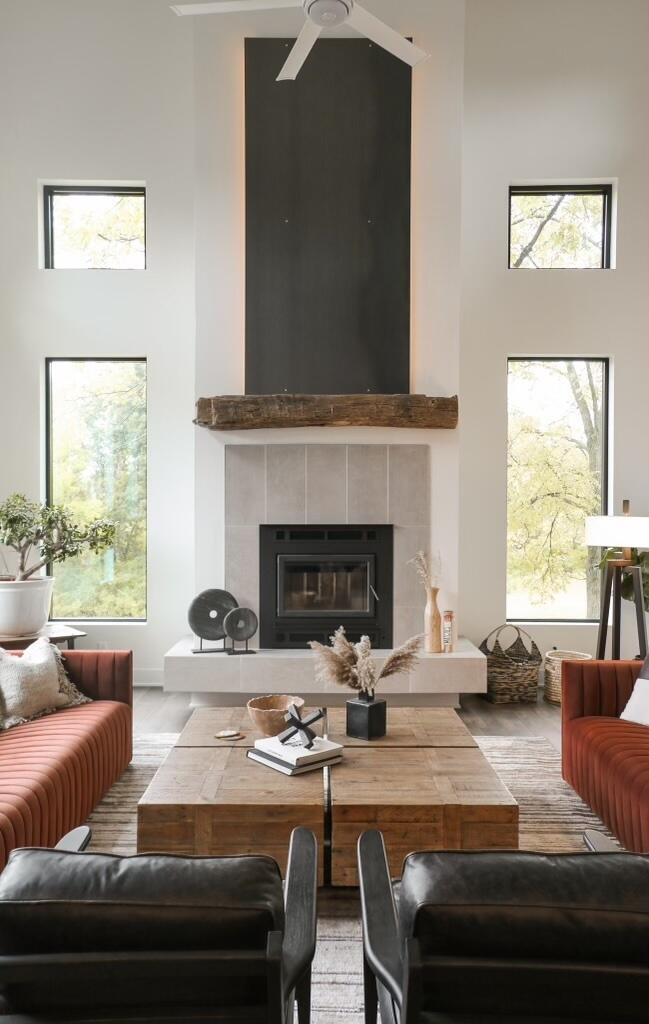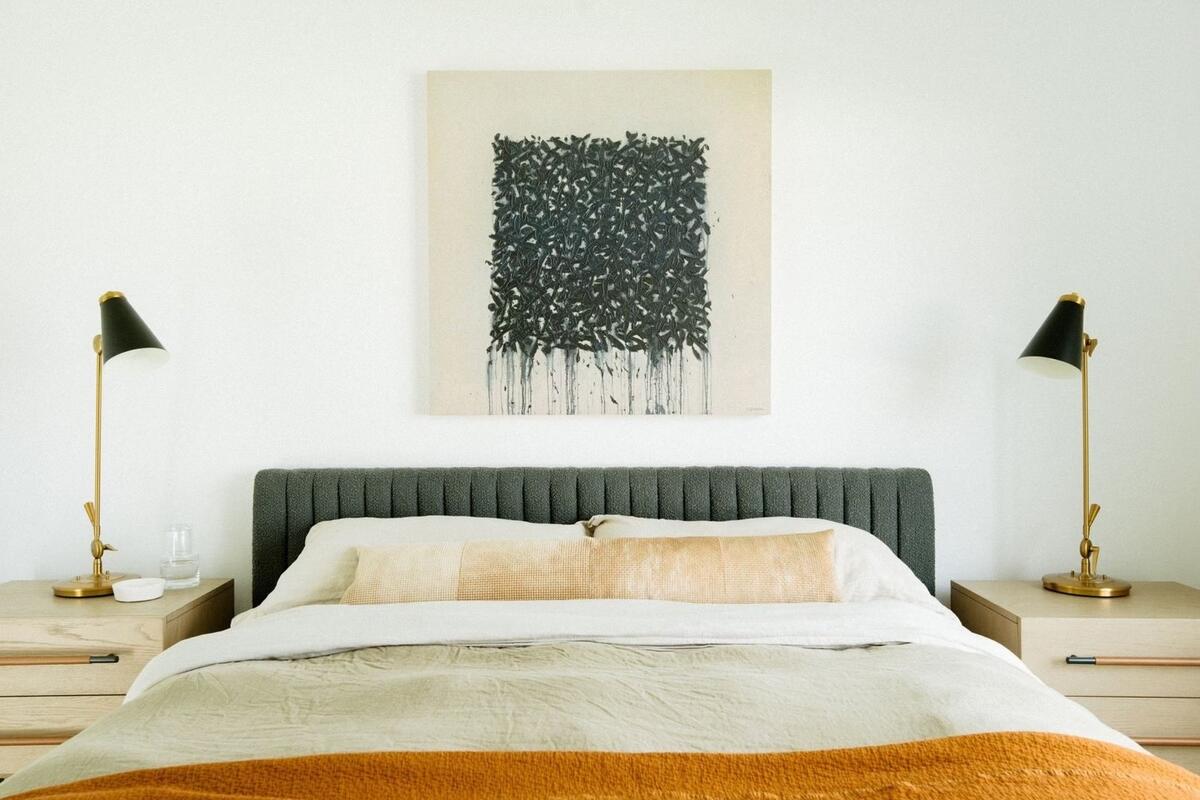The 50 States Project is a series of candid conversations with interior designers across the country about how they’ve built their businesses. This week, Des Moines, Iowa–based designer Julie Lyle of Indie House tells us how she implemented a finder’s fee for contractors, what she tells clients who question her value and how she’s growing the design and retail arms of her business while scaling back on project management.
What was the moment that made you decide to launch your firm?
I went to school for design and business, then went back for two additional years studying architecture and interior design at UC Berkeley, so I always knew this is what I wanted to do. After school, I worked for a small home store—it was similar to what I do now, but more furnishings instead of the larger-scale design projects.
After moving back to Iowa from San Francisco, I started my family and then got into medical device sales and was traveling all over the nation. But my now-ex-husband had a construction business, and I would work with him behind the scenes on his remodeling projects.
After living with so many design resources in San Francisco, my dream was always to have a store to bring in lines that I saw were lacking in Des Moines. When I would travel all over the U.S., I would always carve out time to do some research—I started going to the markets in High Point, Dallas and Vegas. I was making connections, curating what I wanted to have in the store, working within my budget to get all the purchasing done and remodel a storefront.
What helped the business take off?
I had some really great clients right off the bat that just trusted my vision and [abilities]. Now we’ve got five employees. It’s a small store, but we do large projects. My reps have told me that people wouldn’t believe how much business we do off of our 1,600-square-foot floor, just because of the business model that we set up.
What model did you launch with, and how has it changed?
When I launched, it was more about bringing in a lot of the furniture lines that weren’t readily available in Des Moines. The store definitely has a unique style—when we opened five years ago, people would be like, "Is this store actually out of Des Moines?"
I saw that shopping on sites like Studio McGee was becoming more and more the norm. This was a way for me to be able to offer for people to come in, work with a designer at no cost, feel the fabrics, and order furniture knowing a little bit more [than if they had shopped online], as well as getting advice on composition and space planning working one-on-one with a designer. I set it up so that we’ve got a section for our wallpaper samples, a huge rug wall with hanging samples, wood samples from the different lines that we carry—it’s a younger, more modern way of shopping for furniture. And then it evolved into so much more.
Was that client-driven—people coming in and wanting more from you?
It was. It started with a lot of walk-ins and great conversations that led to opportunities.
I picked the coolest place in Des Moines [to open the store], right on Grand Avenue, which is the main street. There’s a West Elm on the corner, which is the only store in this East Village area that is not independently owned, and then there’s a store around the corner called Projects that carries really high-end Italian lines—$40,000 sectionals, that kind of thing. I knew that there’d be enough people from one end to the other, and we’re kind of in the middle of that.
Geographically, aesthetically and price point-wise, it seems.
Exactly. We’re a little bit less retail-focused now and much more project-based. We’ve got probably a good 10 projects going on [ranging from] new builds to commercial projects, to complete renovations, to just interiors. It just grew by people asking, “Will you do this?” And then you’re making contacts and meeting up with general contractors and subcontractors. And all of a sudden you’ve got this Rolodex full of people that are skilled at what they do. That’s the business side of it. The creative part is the part that I love.


What is the breakdown of the business today in terms of retail versus residential versus commercial?
I’d say 10 percent is commercial; remodels are a good 60 percent of our business right now; maybe 20 percent is just interiors; and then 10 percent is retail.
[A lot of the contractors I have been working with are already] booked out until December, so I’ve started reaching out to larger contracting firms to [develop] those working relationships as that side of it became too much to manage. I don’t want to be a general contractor and I don’t want to have the liability that’s attached to it. I want to be the designer—the ideas person and the materials person. I want to make things come to life, then hand it off to the contractor. I’m trying to transition to that. There are a couple of projects where I do feel like I’m kind of overseeing [construction and renovation work] and realizing I don’t want to do that. And I can’t get enough done in doing that. But what I do want to do is make the relationships where I’m still ordering all the materials for kitchen cabinets, flooring, tiles, countertops—so I can still order and use my resources for that because that’s beneficial to me—plus a finder’s fee they pay, and then I just do design fee on top of that.
Is that a recent shift for you?
It is—within the last six months or so. I had been doing the remodel stuff, but it was a little more intermittent before, [whereas] now a huge part of the business is remodeling. I’ve had to really start thinking about that and crunching numbers. I need to make a certain percentage margin on these projects, for it to be a wise decision in a business sense. We’ve got [enough] relationships [now] where [it makes sense to charge contractors the] finder’s fee—I’m handing over $100,000 to $200,000 projects, and hopefully they appreciate that.
We’ve run at least four jobs through on this [model], so now I’ll have the data and the numbers and the spreadsheets to [evaluate], "OK, is this advantageous? Is this profitable?"
How did it shift your firm’s profit structure?
Well, it’s much more profitable to just do interiors at retail. However, when people redo their house, even if I can get that portion of it to a 30 percent margin, [furnishing] the entirety of their home is still at that 50 percent margin.
If we’re doing a ton of custom-builds, I could bring on a wholesale cabinetry line. Then I need a bigger showroom, but I could be making that back with the 50 percent margins. I am also looking at a larger warehouse space that has a receiving dock and [thinking about] bringing in all sorts of awesome furniture [and] making it our style. It’d be a little more industrial, where people can come and just buy $30,000 or $40,000 of furniture every weekend because that’s what’s on my floor right now. It would be almost a destination location, with a little bar or coffee shop.
Where you’ll start stocking more too, I’m guessing?
Oh, absolutely, we’d stock five times as much—[and have a] cool vibe, great music playing, just a place people would want to come. A little patio with outdoor furniture on it. So that’s in the works. I’m just starting to look at places down in the Market District neighborhood that might work.
What inspired that? Was it just seeing the need?
Yes. We have Homemakers, which is Nebraska Furniture Mart, and it’s massive, but it’s not the best quality furniture. We’ve got Projects, which is such a 1 percent niche. And then we’ve got people ordering online—and that’s it. So I’ve got a couple of investors interested in [this new idea, which isn’t something I had] when I started the firm and the retail spot. This would be a step up. I stayed within probably $5,000 of the budget that I had planned for me in opening the store, and then as I was gaining clients and growing, I scaled it appropriately—but [this new opportunity is] exciting.


What else can you tell me about the real estate and design scene in Des Moines?
I feel like working with a designer is becoming a little bit more common and accepted every day. It’s not as scary or as costly as people [used to think]. In Des Moines, there are a couple of design firms and a lot of larger-scale architectural design firms. But there’s a lot of opportunity. My [firm] and one other young designer opened up within the last three to five years, and we’re both just slammed. So I think there’s a lot of growth for us right now in Des Moines.
How has your approach to charging evolved over time?
I feel like at the beginning, I didn’t charge for anything.
You were talking about, "Come buy stuff at retail and get designed for free."
Right. That’s how it started—and for the retail customer, we’ll let them do that. If they want to bring in some dimensions and photos of their house, we always have a couple of designers here. [Shoppers] can sit down and we will give our advice and play. Now, if it’s a full-service design client, that no longer happens. There’s a design fee always attached to it. And yes, now I’m at the point where I don’t give anything away for free.
We’re so busy now that I don’t have to fish for the clients and bring them in. Which when you start, that’s what you’re doing. And you’re so grateful for those opportunities that you bend over backward. And we’re not at that point anymore. Now everyone gets the design fee, [and] certain things get marked up. [But with] our furniture, I do still stand strong and just sell our lines at MSRP.
But I want people to know that there’s no benefit for them to go and order stuff on sites like Burke Decor. Order it from me; this is the design fee attached to that; and we just make the process easier [with] receivers unpackaging everything and doing white-glove delivery. And we come in and install and make it beautiful, because even if you pick out pieces without a larger design scheme, it’s never going to end up the same as if we were involved.
Are there clients looking for a deal who think they should be able to get goods for less if they work with a designer instead of paying MSRP?
No, they’re usually not. I just had a client call the other day, and he just bought a house and he’s going to be moving in. He’s like, "I want these rooms done and I want to keep it at $40,000." That client is going to get regular pricing, and the design fee is very minimal—if anything, it’s for our rendering, and that’s it. If it’s a remodel project, that’s where the design fees come in. There are companies out there that do 10 percent design fee upfront, and then [the client] can take the plan and do whatever they want with it. I’m kind of inching toward that, but I don’t hand over any information until they sign the contract and the design fee is paid. They get the overall concept, and I show them the images, get them excited, and then it’s go time when they pay the fee. And then there’s the upcharges on all the materials involved, as well as furniture [charged at] MSRP.
If someone says, “Oh, I can find this online,” I’ve had to go back to consumers, and explain to them, “We’ve space planned this, we’ve coordinated everything, we’ve created beautiful balance. Whether it’s one room or five rooms, to have a cohesive design plan. You’ve touched all of the fabrics, you’ve seen the woods. We know everything matches. You’re going to get it unboxed, delivered to your house. We’re coming in, setting it up, styling.” I was like, “Do you not find value in any of that?” And no one’s going to look at me and say, “No, I don’t.” That’s the value we’re bringing, and that’s why you’re paying the regular price for the furnishings.

Tell me a little bit about your team.
The first woman that I hired had worked for a different design firm here in Des Moines. [She started working two days a week, and] that quickly went to four days a week. She now manages the logistics of all our projects and all of our orders—she’s my logistics coordinator as well as the store manager, and she’ll oversee the other designers and workers. Then I’ve got two other designers who work the floor and work their own projects, but they’re also doing all of their own data entry, invoicing, getting things set up in the POS, inventory, all of it. I have a team member that does all the social media, all the website, all of that stuff—she’ll go to locations and organize photo shoots, come and do video during our installs. And then I outsource my SEO and my website maintenance [with] a firm out of Omaha.
What role have you carved out for yourself? How independent is your team in some of that design work?
They’re pretty independent in the design work. But I’m involved in every single remodel or new construction project, in every commercial project, and then I’m the one that leads the way in the process because I don’t care if it’s me doing it or one of my other three designers doing it. I want our process to be the same. I want it set up where a client could walk in on a Saturday, and anyone that’s working here can pull up their file and answer any questions that they might have about their project. So the process side of things is where I’m going to always be leading the way, and we’re all going to be on the same page in that regard. But as far as just the interior projects, I let [team members] create their own relationships with their clients, as long as [my staff are] being efficient, because that portion of it is on a commission basis. I had to implement commission just so that it kind of reinforces them working efficiently.
Was there any fear around giving away some of that creative control to staff?
No, because our styles are all very similar. If we’re working on a large project, when we just [gather] around the workstation and are throwing out ideas—we’re always on the same page. They’ve already proven themselves. You’ve got to prove yourself in order for me to give that power away. And I don’t know if I would do that if it was someone that wasn’t really in line with our brand.
Having been a rep, I tap into my reps all the time. My girls do the same. We have such great relationships with all of our reps, and they are there to support us 1,000 percent. We have kitchen cabinet people come in, countertop people, they’re wanting us to use them for this and that, and that is so valuable to us. Or if we’re looking for a rug and it’s not in stock, I always say, “Just scour [another] website for hours. Send a picture of the rug to the rep and say, ‘Hey, we’re looking for a rug like this—can you shoot me three or four?’” Tap into your reps, and use those resources.
What does success mean to you today?
Success to me means loving what I do and getting to do it every day. And making people’s lives better because of it. When they’re grateful and they just love the new place they live in. You spend a third of your life, if not more, in your home. And it impacts so much. Decluttering and having a beautiful space, it’s serene and there’s balance. Those things contribute then to the life that that person gets to live every day. So it’s fun to know that it’s such a big impact, and I feel so blessed that I get to do what I do every day and work with the clients that I get to work with. And my team is just so amazing.
To learn more about Julie Lyle, visit her website or find her on Instagram.






























